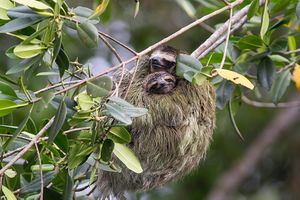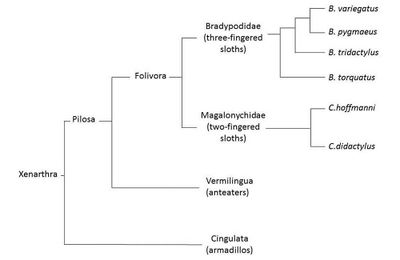Sloth evolution: Difference between revisions
| Line 1: | Line 1: | ||
==Introduction== | ==Introduction== | ||
Despite their similar appearances, the rise of modern sloths is an interesting story of convergent evolution. There are two families of sloths, the two-toed sloth and the three-toed sloth, but there are six different species total. Two-toed sloths belong to the genus <i>Choloepus</i> and three-toed sloths belong to the genus <i>Bradypus</i>. Known for their slow movements and inefficient digestive systems, these creatures populate South American and Central American rainforests. Their diets mainly consist of leaves and fruits. All species of sloths spend their time in the rainforest canopy, spending between 15-20 hours a day sleeping, and only venturing to the floor in order to defecate. The forest floor is full of predators that sloths mainly avoid by hiding in the forest canopy. Their slow movements are due to their extremely slow metabolism, as they attempt to conserve energy by controlling movement speed. [[Image:Sloths hugging .jpg|thumb|300px|right| Fig. 1 <i>Bradypus pygmaeus</i>, a species of three-toed sloth, holding its baby. https://www.biographic.com/keeping-pygmy-sloths-afloat/]] | Despite their similar appearances, the rise of modern sloths is an interesting story of convergent evolution. There are two families of sloths, the two-toed sloth and the three-toed sloth, but there are six different species total. Two-toed sloths belong to the genus <i>Choloepus</i> and three-toed sloths belong to the genus <i>Bradypus</i>. Known for their slow movements and inefficient digestive systems, these creatures populate South American and Central American rainforests. Their diets mainly consist of leaves and fruits. All species of sloths spend their time in the rainforest canopy, spending between 15-20 hours a day sleeping, and only venturing to the floor in order to defecate. The forest floor is full of predators that sloths mainly avoid by hiding in the forest canopy. Their slow movements are due to their extremely slow metabolism, as they attempt to conserve energy by controlling movement speed. [[Image:Sloths hugging .jpg|thumb|300px|right| Fig. 1 <i>Bradypus pygmaeus</i>, a species of three-toed sloth, holding its baby. https://www.biographic.com/keeping-pygmy-sloths-afloat/]] The evolution and microbiota of sloths are unique due to the species' ancestors and the various fungi and bacteria that populate the coarse fur of the animal. The evolution of sloths is interesting because two and three toed sloths appear very closely related, but they have vastly different ancestors, meaning that they evolved through convergent evolution. It was previously believed that these two groups of sloths diverged from the same ancestor, but this has recently been disproven. A better example of divergent evolution would be the evolution of dog breeds. The microbiota of sloths are the microorganisms that live within or on the sloth. Both the fur of the sloth and the digestive system are made of microorganisms, including bacteria, that the sloth benefit from through a mutualistic relationship. | ||
==Genetics/Evolution== | ==Genetics/Evolution== | ||
Revision as of 19:57, 1 December 2019
Introduction
Despite their similar appearances, the rise of modern sloths is an interesting story of convergent evolution. There are two families of sloths, the two-toed sloth and the three-toed sloth, but there are six different species total. Two-toed sloths belong to the genus Choloepus and three-toed sloths belong to the genus Bradypus. Known for their slow movements and inefficient digestive systems, these creatures populate South American and Central American rainforests. Their diets mainly consist of leaves and fruits. All species of sloths spend their time in the rainforest canopy, spending between 15-20 hours a day sleeping, and only venturing to the floor in order to defecate. The forest floor is full of predators that sloths mainly avoid by hiding in the forest canopy. Their slow movements are due to their extremely slow metabolism, as they attempt to conserve energy by controlling movement speed.

The evolution and microbiota of sloths are unique due to the species' ancestors and the various fungi and bacteria that populate the coarse fur of the animal. The evolution of sloths is interesting because two and three toed sloths appear very closely related, but they have vastly different ancestors, meaning that they evolved through convergent evolution. It was previously believed that these two groups of sloths diverged from the same ancestor, but this has recently been disproven. A better example of divergent evolution would be the evolution of dog breeds. The microbiota of sloths are the microorganisms that live within or on the sloth. Both the fur of the sloth and the digestive system are made of microorganisms, including bacteria, that the sloth benefit from through a mutualistic relationship.
Genetics/Evolution
Two-toed and three-toed sloths subside on the same diet and belong to the same order, Pilosa. Phenotypically, they appear almost identical, with the main distinguishing feature being their number of toes. These similar features would make them appear very closely related. However, these two sloths do not belong to the same family. Besides the difference between the number of toes each species has, they also differ in the number of vertebrae in their spines and several other morphological features. By examining the traits of the sloths like locomotion and suspensory posture [1], it was discovered that the Bradypus and Choloepus species evolved through convergent evolution, which is where organisms with different ancestors or from different periods evolved similar phenotypical traits.

Links for citations:
https://link.springer.com/article/10.1007/s10914-011-9174-x
https://www.nature.com/articles/s41559-019-0909-z
Microbiome
Include some current research, with a second image.
Conclusion
Overall text length should be at least 1,000 words (before counting references), with at least 2 images. Include at least 5 references under Reference section.
References
Edited by Cassandra Lis, student of Joan Slonczewski for BIOL 116 Information in Living Systems, 2019, Kenyon College.
